I remember my first Earth Day celebration. A little late to the dance (the first Earth Day was celebrated in 1970), it was April 22, 1975 and it pretty much centered around skipping our college classes and laying out on the HUB lawn. I’m sure there were some glass bottles and cans not being recycled but maybe, just maybe, they were at least making it to a trash can. Fast forward to modern times when it’s almost inconceivable for Americans to toss trash out of car windows and I look with disdain at neighbors who put cardboard out on trash day rather than recycling day. So while Americans are far (far, far, far) from perfect at paying attention to what they do with their trash, we at least have some infrastructure and laws that make most of us consider what to do with that empty Red Bull can.
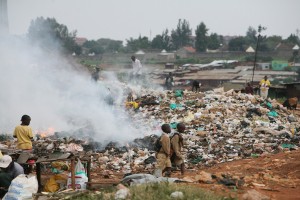 The piles of smoldering trash I’d bike past every day in Kenya were at first revolting to me. Then I had to figure out what to do with the cards, letters, cardboard boxes, plastic bottles, cans etc. that I accumulated. I’d discreetly hide my trash in a pile at the compound where I lived, where all evidence of my consumption would be burned. On the last day in Kenya, Sarah, who worked at the compound, invited me for a meal. As I glanced around her small 2-room house, I saw many of the greeting cards I received over the three years I was in Kenya adorning her walls and Heineken cans strung from corner to corner (yes, they were mine too.) I learned so much in 3 years in Kenya but I found myself sadly out of touch on my last day there.
The piles of smoldering trash I’d bike past every day in Kenya were at first revolting to me. Then I had to figure out what to do with the cards, letters, cardboard boxes, plastic bottles, cans etc. that I accumulated. I’d discreetly hide my trash in a pile at the compound where I lived, where all evidence of my consumption would be burned. On the last day in Kenya, Sarah, who worked at the compound, invited me for a meal. As I glanced around her small 2-room house, I saw many of the greeting cards I received over the three years I was in Kenya adorning her walls and Heineken cans strung from corner to corner (yes, they were mine too.) I learned so much in 3 years in Kenya but I found myself sadly out of touch on my last day there.
I’ve no doubt that the inordinate number of recycled/upcycled/repurposed products that Global Crafts has carried over the years is in part paying penance for my own lifestyle of over-consumption. So it’s great, right? Artisans and craftspeople are using trash as material for their products, ridding their homes of trash, not just by sending it away, but by selling it! The material is readily available and free! Or is it? A large amount of the labor it takes to make something out of waste is the collection and preparation of the material, in most cases longer than the production of the product itself.
Over the years many products that started out made from recycled materials now are made of purchased material. Is a woven telephone wire bowl any less beautiful if it is made out of purchased plastic-coated wire, manufactured specifically to supply South African artisans? Purchased misprinted snack bags used to make purses result in a much more desirable bag because the colors are more vibrant (and there’s no lingering peanut smell). Customers have complained that bags made out of recycled tires smell like – well, tires. The material for Haiti’s famous recycled metal wall art –which at one time was readily available when trade with the US was prevalent—is now imported by container. So the material is often not free anymore and adds to the cost of production, while potentially losing some of the marketing appeal.
So in preparation for Earth Day, April 22nd, let’s go a little deeper into not just who made the product and what it’s made out of, but how the material was sourced. Not all of the stories are sexy but in some cases the production is more sustainable and the products have more longevity in the marketplace. Bags, purses, clutches, and totes made out of recycled/upcycled/repurposed material make up a large part of the Fair Trade handicraft marketplace.
Anita Ahuja, co-founder of Conserve India, challenges herself every year – what kind of recycled/upcycled/repurposed material can be used to make a stylish, trendy bag? This year, Conserve India (I like the fact that the name of the organization is a command) has bags made from “used sails on boats in the Indian ocean,” she writes. And each of the Conserve India bags – whether made from tire, inner tube, seat belts, or the first material we saw, handmade recycled plastic – has a story.
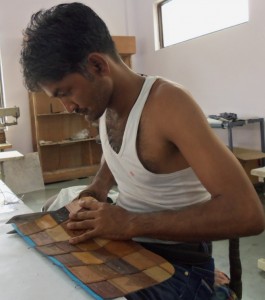 When Anita and her husband Shalabh visited us last year, they brought samples of bags made from the leather patch labels from the waistbands of jeans. Very cool, we thought. We’ll take 100 of six different designs. Wasn’t that easy? For us, yes. The order took much longer to produce than anticipated with much of the delay due to the difficulty of sourcing the labels.
When Anita and her husband Shalabh visited us last year, they brought samples of bags made from the leather patch labels from the waistbands of jeans. Very cool, we thought. We’ll take 100 of six different designs. Wasn’t that easy? For us, yes. The order took much longer to produce than anticipated with much of the delay due to the difficulty of sourcing the labels.
“The labels are procured from the factories where they have been rejected because of misprint,” Anita wrote. “We also source these labels from groups of women who have been trained by us to rip them off from the jeans.” That slight tear in one of the labels that may make the bag appear less “perfect” to a consumer was more than likely caused by a stitch ripper. The leather labels are then sewn into sheets and then into bags, requiring industrial sewing machines and a lot of strength.
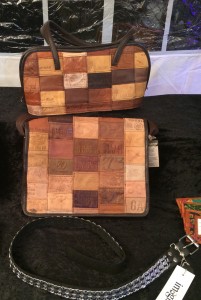 “[The Leather Label Anakali Bag] usually gets “center stage” on one of my tables,” says Amanda Hamilton of A and E Fair Trade. “It’s very popular and I receive many comments. When I explain to some customers where the leather labels come from, many are pleasantly surprised and intrigued to learn more about Conserve India. This bag is not only exquisite, but it’s an excellent introduction to the world up Upcycled products and Fair Trade. When customers first see this bag, they want to touch it and smell the leather. Some recognize the leather labels are from the backs of jeans right away and while other need a little coaxing to recognize what they’re looking at.”
“[The Leather Label Anakali Bag] usually gets “center stage” on one of my tables,” says Amanda Hamilton of A and E Fair Trade. “It’s very popular and I receive many comments. When I explain to some customers where the leather labels come from, many are pleasantly surprised and intrigued to learn more about Conserve India. This bag is not only exquisite, but it’s an excellent introduction to the world up Upcycled products and Fair Trade. When customers first see this bag, they want to touch it and smell the leather. Some recognize the leather labels are from the backs of jeans right away and while other need a little coaxing to recognize what they’re looking at.”
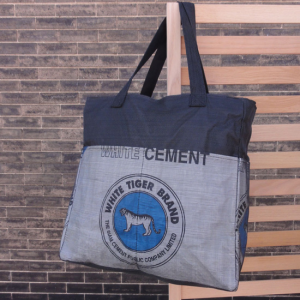 Amanda also carries the White Tiger Carryall bag from Partners for Just Trade that is is made from a used cement bag. “The [strong plastic] cement bags our Cambodian artisans use are collected at construction sites by scavengers after the cement has been used and the bags are empty,” writes Peggy Eng, Product Development and Sales Coordinator for Partners for Just Trade. “Usually the bags then go to the market to be sold by another vendor but our group prefers to pay the market price directly to the scavenger. Cement dust clings to everything and it takes more than a quick rinse to prep the bags for their next incarnation. Our artisans used to clean the bags themselves but now they pay the scavengers an extra fee to do it.”
Amanda also carries the White Tiger Carryall bag from Partners for Just Trade that is is made from a used cement bag. “The [strong plastic] cement bags our Cambodian artisans use are collected at construction sites by scavengers after the cement has been used and the bags are empty,” writes Peggy Eng, Product Development and Sales Coordinator for Partners for Just Trade. “Usually the bags then go to the market to be sold by another vendor but our group prefers to pay the market price directly to the scavenger. Cement dust clings to everything and it takes more than a quick rinse to prep the bags for their next incarnation. Our artisans used to clean the bags themselves but now they pay the scavengers an extra fee to do it.”
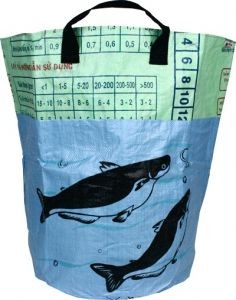 Like cement bags, feed bags are perfect for making large bags not only because of their availability but also because of their size. Also working with craftspeople in Cambodia, Malia Designs sells large round bins with handles made from plastic feed bags. “The feed bags are sourced in Vietnam,” Malia Designs’ founder Lia Valerio writes. “There is a large fish farming industry there and the bags were initially used to hold the grain that they feed farmed fish (hence, why they have the fish patterns). They are then thoroughly cleaned and recycled into our bags.”
Like cement bags, feed bags are perfect for making large bags not only because of their availability but also because of their size. Also working with craftspeople in Cambodia, Malia Designs sells large round bins with handles made from plastic feed bags. “The feed bags are sourced in Vietnam,” Malia Designs’ founder Lia Valerio writes. “There is a large fish farming industry there and the bags were initially used to hold the grain that they feed farmed fish (hence, why they have the fish patterns). They are then thoroughly cleaned and recycled into our bags.”
The manager of The Bridge, Sara Russell, finds the best selling point of the feed bag bins is their versatility. “Holland is right on Lake Michigan- so in the summer we get a lot of tourists who are camping and/or rent cottages on the lake and visiting our sandy beaches, These bags are GREAT for the beach. In the summer we display them stacked with beach towels, perfect for hauling wet swimsuits and beach/sand toys. They are inexpensive, lightweight and can be washed or damp-wiped out. If you set them down on the ground- they don’t tip over. Then when you don’t use them – they fold flat for storage- also great for boats! In the fall we sell them when the college students are arriving, for laundry.”
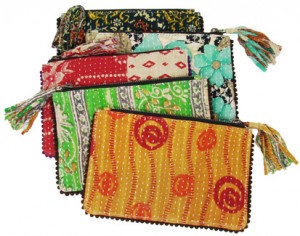 Fair Trade fabric bags are more often than not made from recycled fabric. When asked about the recycled bags they carry, Kelly Weinberger the founder of WorldFinds said, “Our most popular repurposed textile is Kantha, which can now be found all over India. The founder of our artisan group has a friend who collects used kantha quilts from women in several different regions of India. The history of Kantha goes way back – women used to take their worn cotton saris, which would be super soft from washing them on rocks, and stitch two together (front/back) with an overall running stitch to make blankets for their babies. The sari quilts with the running stitch became known as “Kantha”. Women still make them for babies, but also for decoration, and now as an industry since they have become so popular. … [T]he money they make from it will provide them with income for new saris as well as other necessities. The larger pieces of the Kantha quilts get turned into our larger bags, the pieces left from those get turned into our small accessories, and the remaining scraps from those get turned into our Kantha jewelry!”
Fair Trade fabric bags are more often than not made from recycled fabric. When asked about the recycled bags they carry, Kelly Weinberger the founder of WorldFinds said, “Our most popular repurposed textile is Kantha, which can now be found all over India. The founder of our artisan group has a friend who collects used kantha quilts from women in several different regions of India. The history of Kantha goes way back – women used to take their worn cotton saris, which would be super soft from washing them on rocks, and stitch two together (front/back) with an overall running stitch to make blankets for their babies. The sari quilts with the running stitch became known as “Kantha”. Women still make them for babies, but also for decoration, and now as an industry since they have become so popular. … [T]he money they make from it will provide them with income for new saris as well as other necessities. The larger pieces of the Kantha quilts get turned into our larger bags, the pieces left from those get turned into our small accessories, and the remaining scraps from those get turned into our Kantha jewelry!”
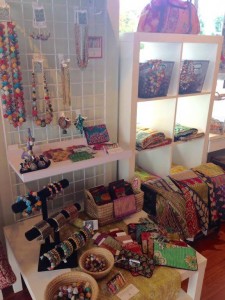 Christine Schwartz of 5 Oceans Fair Trade says the bestselling feature of the product is, “a combination of the quality of the product and the price. Then again, it could be the uniqueness and the style and the color! They are so unique and because of the amazing color, really can match any outfit and make a fashionable statement.” When asked how she displays the Kantha bags, Christine said, “We have our recycled Sari jewelry in one section of the store (together with some Kantha throws from another wholesaler) We also have a small card with a photo of women wearing Sari’s on the front, and on the reverse a short description of what the product is made from. Customers love connecting to our artisans, the story, and the feel of the fabric.”
Christine Schwartz of 5 Oceans Fair Trade says the bestselling feature of the product is, “a combination of the quality of the product and the price. Then again, it could be the uniqueness and the style and the color! They are so unique and because of the amazing color, really can match any outfit and make a fashionable statement.” When asked how she displays the Kantha bags, Christine said, “We have our recycled Sari jewelry in one section of the store (together with some Kantha throws from another wholesaler) We also have a small card with a photo of women wearing Sari’s on the front, and on the reverse a short description of what the product is made from. Customers love connecting to our artisans, the story, and the feel of the fabric.”
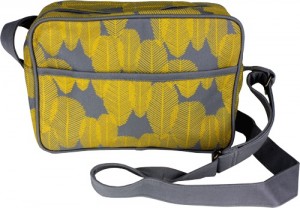 Using scrap fabric for its recycled fabric bags, Malia Designs helps address the discarded waste from the Cambodian garment industry destined for landfills. “ The left over material is sold by fabric vendors in outdoor markets instead of tossed into the dump.” Lia writes. “This is where we source all of our base materials. Then the material is hand screen printed with our original designs and made into our beautiful bags.”
Using scrap fabric for its recycled fabric bags, Malia Designs helps address the discarded waste from the Cambodian garment industry destined for landfills. “ The left over material is sold by fabric vendors in outdoor markets instead of tossed into the dump.” Lia writes. “This is where we source all of our base materials. Then the material is hand screen printed with our original designs and made into our beautiful bags.”
So this Earth Day, take the phrase “one person’s trash is another person’s treasure” a little further. One person’s trash, with some extensive preparation of the material and hours of labor can eventually become another person’s treasure. Consumers should not only be impressed with the material but also the human ingenuity and the time it takes to not only make the product but also prepare the material. And if buying a Fair Trade product made from trash makes us feel a little better about our lifestyle of overconsumption, I guess that’s okay too.
